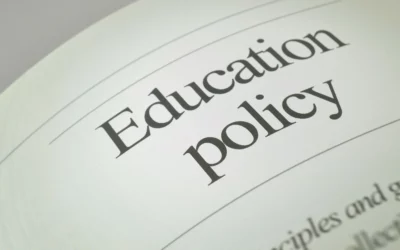
Written by Christine Cooke Fairbanks
June 8, 2023

Arizona’s education choice is saving the state money, according to a new Wall Street Journal piece. This finding is not only good news – it’s contrary to the warnings of some opponents of school choice.
Education choice in the form of microschools are also saving many kids from education environments that do not work for them mentally and emotionally.
Public school experience, pre-pandemic
Jenna Madsen – a speech language pathologist – and her husband have three daughters. When their daughter was old enough to start kindergarten, they enrolled her in a public school, where Madsen quickly observed how much her daughter was struggling.
Her daughter was very emotional during this time. She would leave for school in a bad mood and come home in a bad mood. This made anything extra – like soccer or dance – extremely difficult. Madsen was concerned that her daughter was dealing with feelings of being overworked and overstressed at such a young age. The situation just did not sit right with Madsen.
Then the pandemic hit, and all kids went home for the year. Before the new school year started, Madsen asked around about options and learned that others in her neighborhood were using Prenda, a microschool model that started in Arizona several years ago.
Her neighbor was starting as a Prenda guide for the next year – Prenda offers an online and self-directed curriculum, so it only requires “guides” rather than teachers. Madsen and her husband enrolled their daughter with their neighbor’s microschool for first grade.
Switching to a Prenda microschool
After switching to Prenda, Madsen’s daughter couldn’t wait to go to school – a night-and-day difference from never wanting to go in kindergarten. The difference that made for their family dynamic and her peace of mind as a mother was huge.
Her oldest stayed in Prenda for second and third grade. Her second oldest daughter joined as well for her first two years. The results have remained positive. Rather than counting down the days until school ends, her girls are sad that school is now over for the summer. Both girls will remain in Prenda for the coming school year.
What Prenda microschooling is like
Prenda emphasizes a student’s responsibility for their own learning and teaches concepts like the “growth mindset” – a belief that we can grow past setbacks. Madsen believes this emphasis reduces anxiety for students and gives them a lot more control in their learning. Furthermore, Prenda does not divide kids strictly by grade, instead grouping students into small mixed-age groups (like grouping grades K-2, 3-5, 6-8, etc.). This creates the modern schoolhouse dynamic that exists in many microschools.
Parents can access Prenda either through enrolling with a particular charter school or with education savings account funds. There are a few more regulations for those using the charter school option, but when parents use the ESA model many decisions are simply left up to the individual guide. Parents can choose their own guide (or can become a guide themselves) depending on what best fits their child.
For instance, Madsen had two different Prenda guides this year. Her oldest daughter’s guide incorporated more traditional aspects of schooling, like times-table testing or spelling tests (though the words are chosen by the students). But these traditional aspects are still more self-driven than what is done in public schools.
Prenda offers an online curriculum, with programs like self-paced math, language arts, and eventually self-paced writing programs in older grades. Students set their own goals with their guides and track their own progress. Guides may get alerts if students are way off track – if a student is not progressing toward a goal for a week, for example. But because guides are in the room with students daily, they can usually intervene earlier.
Madsen was a Prenda guide for a year. Her approach was to give more guidelines when students were younger, with the guidelines loosening up as students get older.
Outcomes and experience so far
As for overall outcomes, Madsen’s girls have grown significantly. They experience far less anxiety and show more resilience. Her daughters read at high levels and choose to read a lot. The work they are doing in their individual programs is advanced – something that is not always captured in testing.
Prenda guides can and do test students, but the program does not put a lot of emphasis on testing. Madsen likes that because she is not a huge fan of putting so much emphasis on testing, even though at times she wonders whether it is a disservice to have the students tested so infrequently. Recently, her guides have used a standardized test as a bench marker.
Advice to interested parents
To other parents who are considering Prenda, Madsen says, “It’s 100% worth it.” In hindsight she considers the decision to choose Prenda for her daughters to be a “no-brainer.”
Outside people have questioned her choice, asking whether Prenda is enough. Their concerns include things like the program requiring fewer hours in the day than a traditional school.
At times Madsen herself has wondered about whether her girls are getting enough social diversity. Her daughters’ microschool class sizes are quite small – no larger than 10 kids – and the same kids have stayed with each other over the years.
However, her daughters’ class is about half boys and half girls, and there is diversity of ethnicities and religions in the group. Furthermore, the students feel close to each other and cared for since they have stayed together throughout certain grades. For her daughters, the smaller class size has been a positive aspect.
Even more crucial to Madsen is having her kids’ support of their education. That is exactly what she has found with Prenda.
“School is not something they have to do now. School is something they get to do. And I think it is from the Prenda core values and from the more balanced lifestyle it provides – there are reduced hours and it gives them more control over how we spend those hours.”
Conclusion
Prenda microschools are in some respects a mix between a home-school environment and a private school experience. Kids can work alongside other students while learning at their own pace, usually from the comfort of someone’s home. The self-driven online curriculum is provided, which means “guides” are free to guide rather than teach or plan lessons.
As education innovation spreads, Prenda is an option that many parents may want. State policies should support and facilitate such options so that students who might learn best using this model have the opportunity to do so.
Helpful resources related to this article:
Q&A with Prenda’s Chief Empowerment Advocate Kaity Broadbent

Insights: analysis, research, and informed commentary from Sutherland experts. For elected officials and public policy professionals.

- Prenda microschools can work well for students who struggle with anxiety, who might flourish with a smaller group of students in a home setting.
- Prenda emphasizes responsibility and control over one’s own learning and teaches concepts like the growth mindset.
- Parents can find variety among Prenda guides regarding structure, testing and location, depending on a student’s needs.
Read More
Looking at Supreme Court and religious freedom through the lens of the presidential campaign
Two constitutional issues highlight similarities and differences between the Biden and Trump administrations.
Education policy to consider during the 2024 election season
Here’s a look at what each presidential candidate is likely to focus on in education, given their track records and campaign platforms.
Ignoring the text of the Constitution is a mistake
A written Constitution is entirely superfluous if the document is simply meant to give the people what they want.


